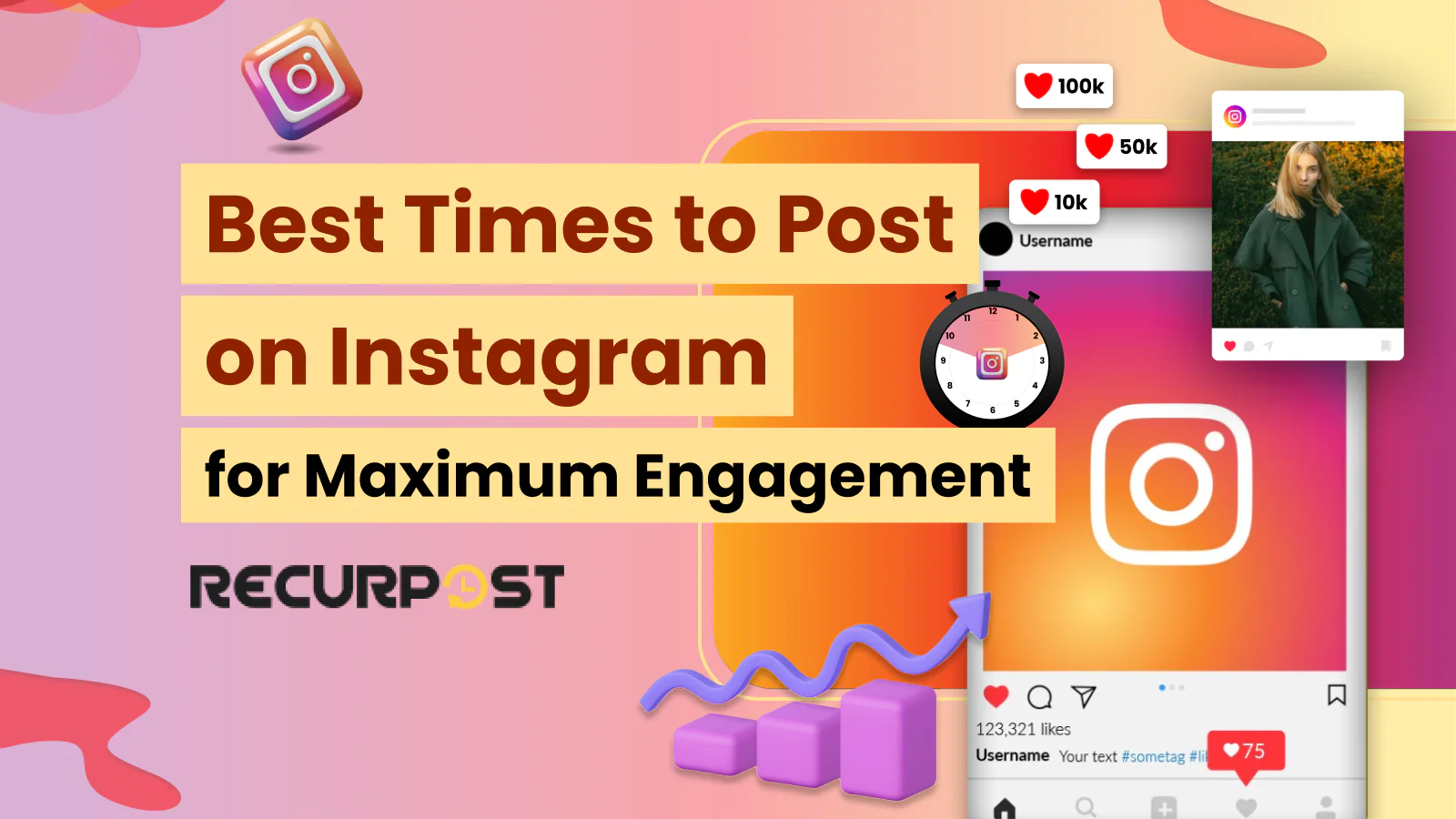The best time to post on Instagram refer to specific hours during the day when users are most likely to engage with content, measured through likes, comments, shares, and reach.
An in-depth analysis of over 2 million Instagram posts shared via RecurPost in the past 90 days shows that these optimal windows vary by content type and day of the week. Instagram engagement patterns in 2025 have evolved, urging marketers to depend on real-time, data-backed decisions rather than outdated posting myths.
The study categorized content into Reels, carousels, and static images and measured their engagement efficiency using metrics such as interaction-to-impression ratios and follower activity curves.
Unlike conventional averages, RecurPost’s model offers granular, content-specific time slots informed by live audience behavior trends. Marketers are advised to schedule posts within these data-proven windows to achieve measurable gains in visibility, especially as Instagram’s algorithm favors recent, high-performing posts.
Let’s examine the best time to post on Instagram.
TL;DR
- Global engagement peaks on Instagram fall during early afternoon (1–3 PM) and late afternoon (3–6 PM), with a secondary high between 8–11 PM. Interaction drops sharply during late-night and early-morning hours (12–6 AM).
- Best hours by day:
- Mon: 3-5 PM; 5–6 PM; 8-9 PM
- Tue: 9-11 AM, 3–6 PM
- Wed: 11 AM and 8-11 PM (top day overall)
- Thu: 8–1 1PM
- Fri: 7-10 AM, 6-9PM
- Sat: 9-11 AM; 8–11 PM has decent traffic
- Sun: 10 AM–12 PM and 7–11 PM
- Feature-specific timing:
- Reels: 9 AM–12 PM, Mon–Fri
- Stories: 4–6 PM Weekdays
- Live: Weekdays 7–9 PM (Tues/Thu); weekends 1–4 PM
- Regional peaks:
- India: Weekday evenings ~7:30 PM; Saturday ~8:30 PM
- (Also covers AUS, USA, UK, Malaysia, Canada, Europe.)
- Worst times: Late night/early morning (post-9 PM on weekdays, before 6–8 AM weekends); standard work hours; Saturday afternoons.
- Engagement drivers: Prioritize user interest, post recency, and continuously refine timing via Insights and third-party tools.
When is the Best Time to Post on Instagram in 2025?
Based on 2 million Instagram engagement insights from June 2025, the top-performing hour is Thursday at 9 PM, followed by Sunday and Wednesday evenings (8–10 PM). These windows consistently generate high likes, comments, and reach, marking them as the most effective times to expand visibility and drive audience interaction.
Unlock Your Optimal Instagram Posting Time
Use this free tool to discover exactly when your content will get the most likes, views, and shares.
⭐ 4.3/5 average user rating (based on 2,000+ reviews)
Instantly find your best time to post on Instagram | trusted by 5,000+ creators, rated 4.3★| powered by 2025 engagement trend data.
What’s Different About Instagram Posting Times in 2025?
As 2025 progresses, the best time to post on Instagram keeps shifting due to user behavior and evolving platform algorithms. Analyzing over 2 million Instagram engagement data points through June 2025, the trends differ sharply from previous years.
Extended Evening Engagement:
Unlike previous years when engagement declined after 21:00, the 2025 data reveals a significant rise in late-evening activity. Engagement now peaks at 21:00 on Thursdays, and remains strong until 22:00–23:00 on Sundays and Wednesdays, signaling increased screen time during late hours across weekdays.
Earlier Weekend Activity:
Instagram usage on weekends has shifted earlier in the day. On Saturdays, engagement gradually builds after 09:00 but reaches its highest between 13:00 and 17:00. On Sundays, mornings show lower activity, with peak engagement shifting decisively to the evening hours, especially between 19:00 and 22:00.
Midweek Dominance:
While Monday and Friday were previously favored for Instagram posting, 2025 data shows a clear shift: Wednesdays and Thursdays consistently deliver the highest engagement across industries. Engagement peaks sharply on Thursday at 21:00 and Wednesday at 21:00, with both days also maintaining strong performance from 20:00 to 22:00. In contrast, Monday and Tuesday show moderate engagement, and although Friday performs well in the evening, it doesn’t match midweek spikes.
Algorithm Prioritization Changes:
Instagram’s 2025 algorithm updates have intensified the impact of recency, making precise posting during high-engagement hours more essential than ever. Missing these windows often results in lower initial reach and slower content momentum.
Global Synchronization:
With increased global content visibility and overlapping online hours, the window for the best posting has become narrower yet more consistent across time zones. Evening slots around 20:00–22:00 now hold cross-regional relevance for both local and international audiences.
Global Best Time to Post on Instagram
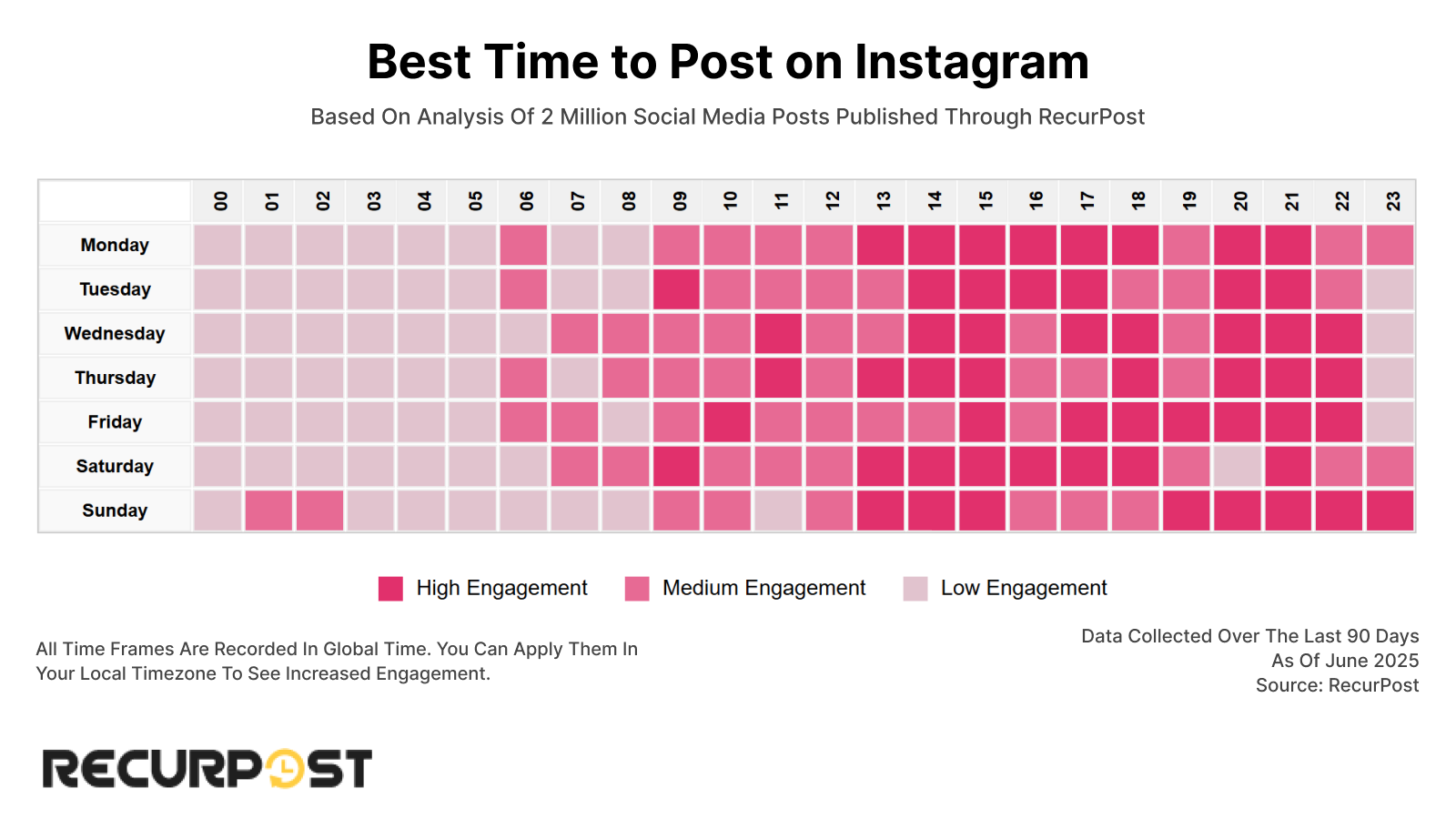
Instagram insights show that posting during late afternoons and evenings drives the most engagement. Rather than early slots, activity thrives from 15 PM to 22 PM.
- Engagement climbs steadily from 13:00 (1 PM), peaking between 15:00 and 17:00 on weekdays, particularly Tuesday and Friday.
- Unlike older patterns, evening activity remains very strong, especially from 20:00 to 22:00, with standout performance on Wednesday, Thursday, and Sunday nights.
- The 21:00 (9 PM) slot dominates Instagram engagement, often leading to metrics previously underestimated.
- Engagement begins to taper off after 22:00, but still outperforms early-morning and late-night hours.
- Meanwhile, posting between 1 AM and 4 AM remains the worst time to post on Instagram, with minimal user activity reported.
Best hour to post on Instagram
Curious whether your post timing matches your audience’s online habits? According to Instagram’s 2025 engagement insights from over 2 million posts, here’s a fresh hour-by-hour performance breakdown:
🕔 05:00 – 07:00:
While this early slot offers modest returns, it benefits fitness, motivational, and business accounts targeting early risers, though it falls short compared to peak slots.
🕖 07:00 – 09:00:
Engagement lightly picks up as weekday commuters check phones. Still, it’s no longer considered a top-performing window in 2025.
🕙 10:00 – 12:00:
Late morning activity spikes on Tuesdays and Wednesdays, ideal for insightful, relatable posts that appeal to wide audiences.
🕛 12:00 – 14:00:
Once a sweet spot, midday now plays a secondary role, performing moderately well, especially on Fridays and Tuesdays, yet overshadowed by evening surges.
🕒 15:00 – 17:00:
A prime engagement zone, especially Monday through Friday. Great for teasers, viral entertainment, or visual-first content during short user breaks.
🕔 17:00 – 19:00:
Steady interaction continues, though slightly less intense than evening peaks. Lifestyle, food, or relaxation-themed content excels here.
🕖 19:00 – 21:00:
Instagram’s strongest window. 9 PM wins big on Wednesday, Thursday, and Sunday. Best for ecommerce, fashion, or impactful visuals.
🕘 21:00 – 23:00:
Engagement peaks sharply at 21:00, especially on Thursday and Sunday. While it tapers after 22:00, this window remains highly effective for evening routines, reflective posts, and inspirational content.
🕚 23:00 – 01:00:
Engagement wanes after 11 PM. Night owl or international audiences may still interact, but results dip notably.
The Best Time to Post on Instagram on Monday
Kick off your week by targeting Instagram’s Monday engagement peak: the late afternoon to evening stretch. The most impactful time to post is at 20:00 (8 PM), delivering the day’s highest interaction. Other high-performing windows include 17:00 (5 PM) and 15:00 (3 PM), forming a strong block from 15:00 to 21:00 to reach active users.
Worried that “Monday blues” might mean low visibility? The data disagrees. While working hours see moderate traction, Instagram engagement surges post-work, making Monday a consistently smart day to connect with followers and boost visibility.
The Best Time to Post on Instagram on Tuesday
Tuesday brings a wave of Instagram activity beginning mid-morning and continuing into the early evening. The top-performing posting time is 17:00 (5 PM), with strong engagement also seen at 15:00 (3 PM), 18:00 (6 PM), and an early spike at 09:00 (9 AM) that’s ideal for catching users starting their day.
As one of the most engagement-rich weekdays, Tuesday offers several optimal windows aligned with user routines, from workday pauses to evening downtime. Leveraging these high-performing slots can significantly enhance your post’s visibility and interaction.
The Best Time to Post on Instagram on Wednesday
Wednesday emerges as one of the top-performing days for Instagram engagement, particularly during the evening. Peak interaction occurs at 21:00 (9 PM) and 20:00 (8 PM), with a strong carryover at 22:00 (10 PM). Daytime activity is also notable, especially at 11:00 AM and 17:00 (5 PM).
Eastern Time audiences show increased responsiveness after work, making evening slots especially effective. While morning hours like 09:00 and 11:00 remain relevant, the evening now holds the dominant position for user activity in 2025.
On the West Coast, these same patterns persist with a slight delay. Posting between 18:00–20:00 PT is ideal for tapping into that same peak engagement window.
The Best Time to Post on Instagram on Thursday
Thursday is consistently one of Instagram’s most active days, with the highest engagement peaking at 21:00 (9 PM), the top-performing hour of the entire week. Additional strong windows are seen at 20:00 (8 PM) and 22:00 (10 PM), making Thursday evenings a prime opportunity to connect with your audience.
Although 11:00 AM continues to draw solid interaction, the trend in 2025 strongly favors evening usage. Posting between 20:00 and 22:00 aligns perfectly with end-of-day habits and early weekend preparation, offering a high-impact timeframe for reach and engagement.
The Best Time to Post on Instagram on Friday
Friday engagement builds gradually through the late morning and peaks powerfully in the evening. The best times to post are 20:00 (8 PM) and 21:00 (9 PM), both of which register the highest interactions, making them ideal for riding the weekend momentum.
There’s also consistent engagement from 13:00 to 17:00, particularly around 15:00 and 17:00, providing multiple windows to connect with your audience throughout the day.
While early morning (before 08:00) and late night (after 23:00) activity remains low, Friday evening posts, especially those tied to entertainment, lifestyle, or weekend themes, tend to generate strong results.
The Best Time to Post on Instagram on Saturday
Saturday engagement is particularly strong in the early afternoon. The peak time is 13:00 (1 PM), which sees the highest interaction, aligning with relaxed weekend behavior and mid-day Instagram browsing.
Engagement stays high from 12:00 to 17:00, with strong traction at 14:00 and 17:00. These windows offer extended exposure, especially for shopping, lifestyle, and entertainment posts.
While 09:00 offers moderate results, the midday hours now outperform it. Evening posts at 21:00 and 23:00 also show solid results, making Saturday versatile with several strong posting windows.
Saturday is not a bad day to post at all, it delivers some of the most consistent engagement throughout the day, provided you time it within those top-performing hours.
The Best Time to Post on Instagram on Sunday
Sunday generates consistent engagement during the afternoon, with activity peaking in the evening. Top-performing time slots are between 1 PM and 3 PM, and again from 8 PM to 10 PM, with 9 PM standing out as the day’s strongest hour.
So, is Sunday good for Instagram posting? Definitely. Although mornings are less active, usage steadily climbs as people unwind and browse during the evening.
Many think Sundays are quiet due to offline commitments, but the data suggests otherwise. Engagement spikes in the evening, making it ideal for calm, reflective, or entertaining content that connects before the workweek begins.
Is midnight a good time to post on instagram?
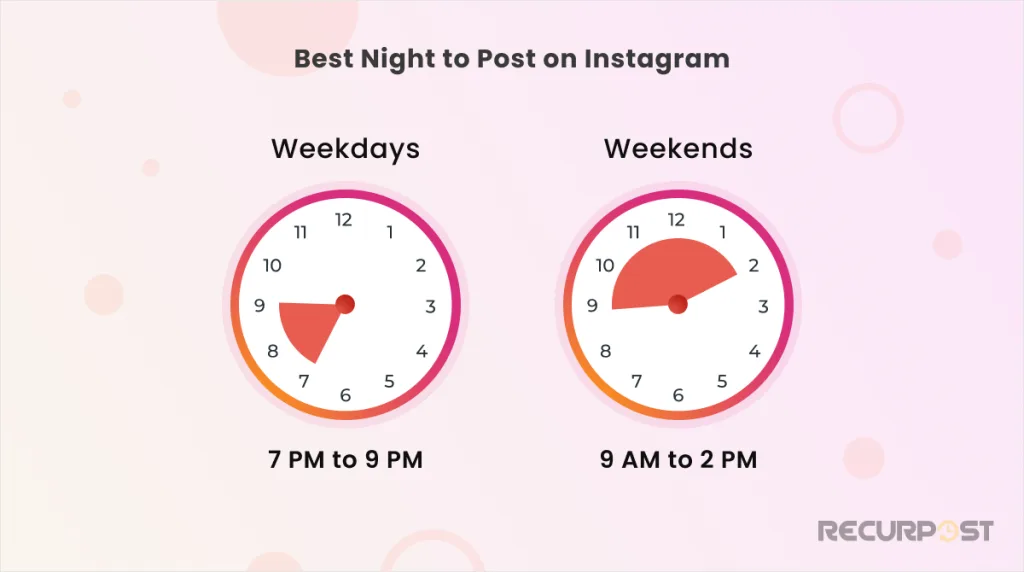
Posting on Instagram at midnight can be effective, but it depends on the day. While engagement usually drops after peak evening hours, some late-night periods still offer solid interaction, especially on weekends.
High-Engagement Nights (Based on Jun-2025 Data):
- Sunday night stands out, with the highest engagement recorded around 9 PM and continuing strongly into the late evening. It’s a moment when users are relaxed, scrolling, and mentally preparing for the week ahead.
- Friday nights also perform well between 8 PM and midnight as people wind down, looking for entertainment and inspiration.
- Saturday shows a temporary dip around 9–11 PM but rebounds just after midnight, particularly from 1 to 2 AM, thanks to night owls and content creators still active.
⚠️ Lower Engagement:
- Engagement falls noticeably after 10 PM from Monday to Thursday. By midnight, interaction levels dip unless your audience includes global viewers or night-shift users.
Best Time for Instagram Reels, Stories, and Live
The optimal timing for different Instagram features can boost your engagement. Let’s break it down:
Best Time to Post Reels on Instagram
The best time to post Reels on Instagram is between 9 AM and 12 PM, Monday through Thursday. Reels tend to perform best during these hours, with peak engagement typically occurring on Wednesday. For maximum visibility, try posting Reels around 11 AM on Wednesdays, as this is considered the best time to post Reels on Instagram.
Want to make the process even easier? Check out our detailed guide on How To Schedule Instagram Reels and ensure your content always hits the mark at the right time!
Best Time to Post Stories on Instagram
Stories peak in engagement between 4 PM and 6 PM on weekdays, particularly on Fridays when users are winding down and catching up before the weekend.
Best Time to Go Live on Instagram
For Instagram Live, the best window is 7 PM to 9 PM on weekdays, especially Tuesdays and Thursdays, while weekend engagement tends to be strongest from 2 PM to 4 PM, ideal for casual, lifestyle-driven content.
Keep in mind these are general benchmarks. Reviewing Instagram Insights regularly will help fine-tune the best timing based on your audience’s activity.
The best time to post on Instagram according to the locations
If you’re unsure about the best time to post on Instagram in your region, don’t worry, we’ve mapped ideal windows for key markets around the world.
Whether you’re based in Australia, the USA, the UK, Malaysia, Canada, Europe or India, these location‑specific guidelines can help sharpen your posting strategy and improve reach.
Here are the specifics of when and where to make the most of your Instagram posts.
| Location | Weekdays | Weekends |
|---|---|---|
| Australia | 6 PM – 8 PM | 11 AM – 1 PM |
| United States of America | 8 AM, 5 PM | 9 AM |
| United Kingdom | 8 AM, 5 PM | 12 PM – 2 PM |
| Malaysia | 12 PM – 2 PM, 6 PM – 8 PM | 10 AM – 12 PM |
| Canada | 9 AM, 6 PM | 10 AM – 12 PM |
| Europe | 8 AM, 5 PM | 10 AM |
| India | 7:30 PM | 8:30 PM |
Best time to post on Instagram Australia
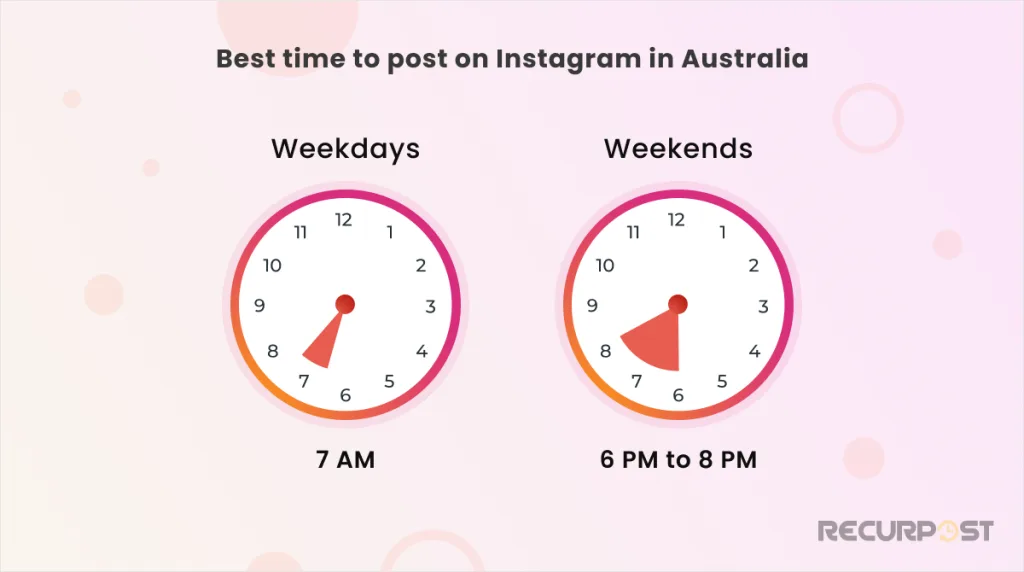
The best time to post on Instagram in Australia aligns with users’ workday and leisure rhythms. Weekdays starting at 7 AM are ideal, coinciding with early engagement as people begin their day. On weekends, peak activity shifts to the 6 PM to 8 PM window, when many Australians are winding down from the day or enjoying outdoor activities and brunch, making them more active on social media.
Best time to post on Instagram in the USA
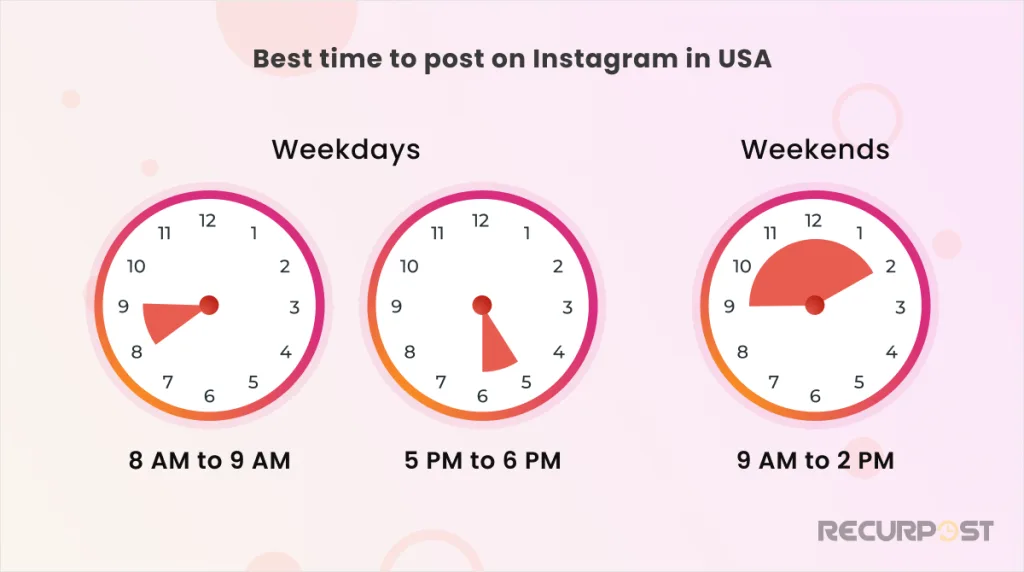
Generally, weekdays see higher engagement than weekends. Tuesday through Friday are often considered the best times to post on Instagram in the USA, with Wednesday and Thursday typically seeing peak activity. Is Sunday a good day to post on Instagram? While it can work for some niches, it’s generally not as effective as weekdays. Similarly, is Saturday a bad day to post on Instagram? It’s not necessarily bad, but engagement tends to be lower compared to weekdays.
When it comes to specific times, here’s a breakdown:
a. Weekdays
- Morning: 8 AM – 9 AM
- Evening: 5 PM – 6 PM
b. Weekends
- Morning – 9 AM to 2 PM
The best time to post on Instagram on Tuesday often falls within these ranges, with a sweet spot around 11 AM or 7 PM.
For those wondering about the best time to post on Instagram at night or the best time to post in the evening on Instagram, the 7 PM – 9 PM window typically performs well. But is it bad to post on Instagram at night? Not necessarily. In fact, for certain audiences, late-night posts can be quite effective.
This brings us to a common question: Is 10 PM too late to post on Instagram? While it’s later than the usual peak times, it can still be effective, especially if your target audience includes night owls or spans multiple time zones.
Now, let’s address the flip side. Is there a bad time to post on Instagram? While no time is universally “bad,” certain periods see consistently lower engagement. The worst time to post on Instagram is generally between 1 AM and 5 AM, when most users are asleep. Similarly, the worst day to post on Instagram is often Saturday, as many users are engaged in offline activities.
Best time to post on Instagram UK
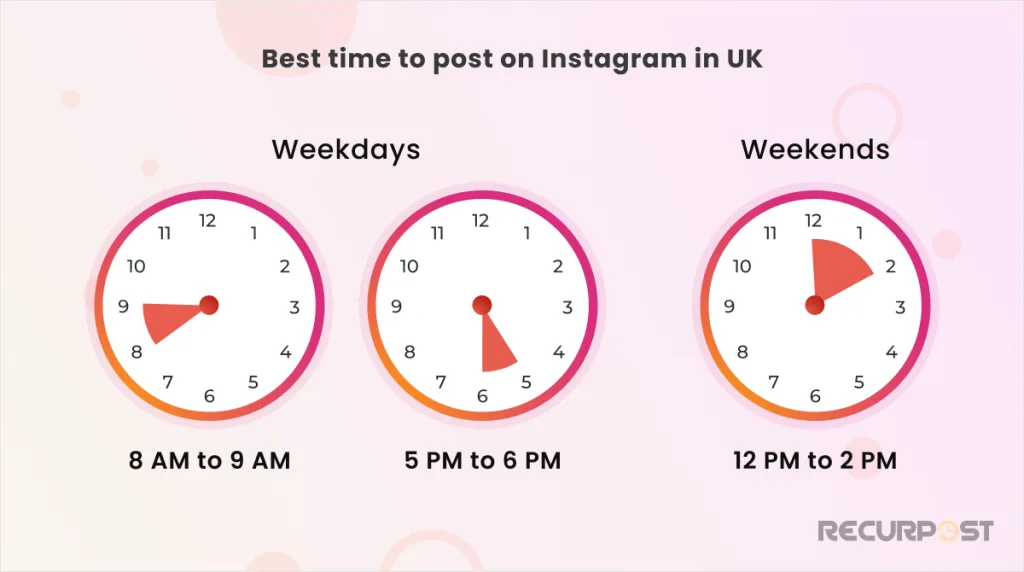
Determining the best days to post on Instagram in the UK involves considering factors like work schedules, commuting patterns, and weekend activities. While weekdays often see higher overall engagement, weekends can also be effective, especially for leisure-related content.
While there’s no universally agreed-upon worst days to post on Instagram, understanding potential low-engagement periods can help you optimize your posting schedule. Typically, very early mornings and late nights might experience lower activity.
In general, weekdays tend to see higher engagement than weekends. The best time to post on Instagram UK are:
a. Weekdays
- Morning: 8 AM – 9 AM
- Evening: 5 PM – 6 PM
b. Weekends
- Afternoon – 12 PM to 2 PM
The best time to post on Instagram in the UK often aligns with commuting times and breaks. This typically falls between 8 AM and 9 AM and 5 PM to 6 PM on weekdays. However, the question, “Is 5 PM a good time to post on Instagram?” is valid, as it coincides with the end of the workday for many.
Evening posts can also be effective, but the question, “Is it good to post on Instagram at night?” depends on your target audience. While some users are active late at night, it might not be the peak time for everyone.
Understanding whether Sunday is a good day to post on Instagram or if Saturday is a good day to post on Instagram is crucial. While weekends often see a shift in user behavior, with more leisure time, consider your target audience’s preferences. Additionally, the question, “Is Sunday morning a good time to post on Instagram?” can be explored, as it might align with post-weekend routines.
Remember, these are general guidelines. The best approach is to experiment with different posting times, track your performance, and adjust your strategy accordingly.
Best time to post on Instagram in Malaysia
For Instagram users in Malaysia, the most engaging times to post are on weekdays between 12 PM and 2 PM and again from 6 PM to 8 PM. These windows align perfectly with typical lunch breaks and evening downtime when users are more likely to browse content. Weekend engagement is strongest between 10 AM and 12 PM, tapping into morning routines when people are relaxed and casually scrolling.
Specifically, Saturdays show peak user activity during the 10 AM to 12 PM window, as many users are engaged in light browsing and social catch-ups. Posting within these hours can significantly improve visibility and interaction in the Malaysian market.
Best time to post on Instagram in Canada
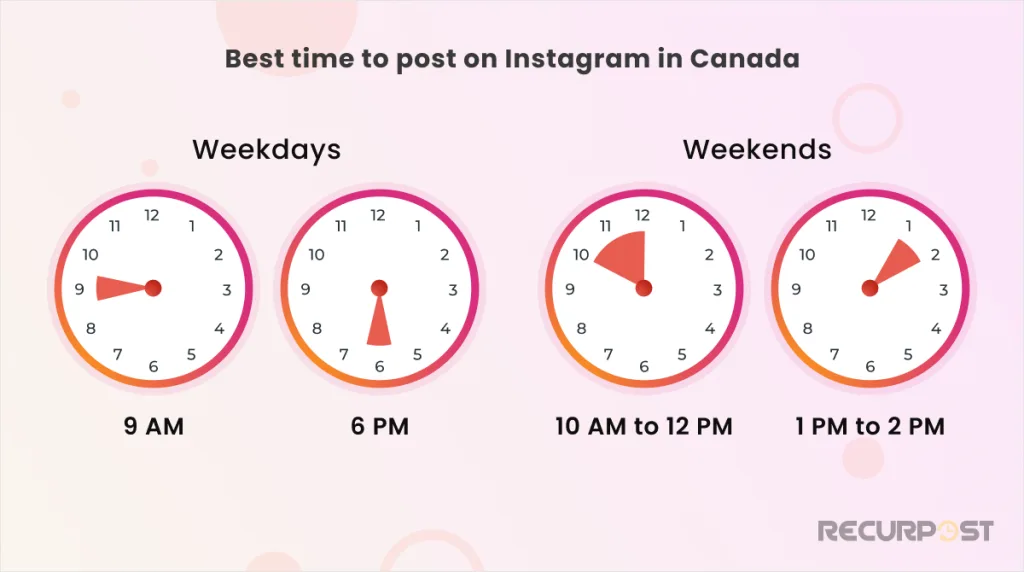
To optimize Instagram engagement in Canada, aim to post around 9 AM or in the early evening around 5 PM to 6 PM, as these times align with high user activity. These hours are especially effective when users are starting or ending their day. Fridays, particularly in the evening, offer strong engagement as people shift into weekend mode. Saturdays also perform well, especially from 10 AM to 12 PM and again at 6 PM, while Sundays maintain momentum during the 6 PM to 9 PM slot.
Avoid posting during very early hours, especially from 1 AM to 5 AM, when user activity is minimal. Midweek mornings on Tuesdays and Wednesdays also tend to deliver lower engagement, so they’re not ideal unless targeting a specific audience.
Best time to post on Instagram in Europe
Despite varying time zones, Instagram engagement in Europe remains consistent, with 8 AM and 5 PM on weekdays being the most active windows. These time slots align with the beginning and end of the typical workday, making them ideal for maximizing reach. On weekends, activity shifts slightly, with 10 AM emerging as a strong hour for posting, capturing users during their slow-paced morning routines.
Best time to post on Instagram in India
In India, the best time to post on Instagram for peak engagement is around 7:30 PM during weekdays and 8:30 PM on Saturday evenings. These hours align with the nation’s leisure routines, capturing users as they unwind and browse content after work or dinner, leading to higher visibility and interaction.
Remember, these guidelines are based on general trends. Your specific audience might have different habits, so it’s crucial to analyze your Instagram Insights for personalized data. Experiment with different posting times and track your results to find what works best for your unique followers.
Optimal Instagram Posting Times for Special Occasions
New Year’s Eve: The best time to post on Instagram on New Year’s Eve is in the late afternoon, around 4 PM to 6 PM, when people are preparing for evening celebrations and likely to be checking updates and sending greetings.
Christmas Day: On Christmas Day, early morning posts around 8 AM to 9 AM are effective as people begin their day and share festive moments, while a later post around 5 PM to 6 PM can catch those winding down from the day’s activities.
Halloween: For Halloween, posting in the early evening, around 3 PM to 5 PM, is optimal as it captures the excitement before nightfall when costumes and festivities begin.
Labor Day: Labor Day tends to see good engagement when posting in the morning, around 9 AM to 11 AM, as people enjoy a relaxed start to the holiday, often checking social media during breakfast or brunch.
Mother’s Day: The best time to post on Instagram on Mother’s Day is mid-morning, around 9 AM to 10 AM, when many are sharing tributes and family photos.
Valentine’s Day: On Valentine’s Day, posting early in the morning, around 8 AM to 9 AM, is effective for reaching those looking to celebrate or share messages of love, as well as an evening post around 7 PM to 8 PM as celebrations continue.
Overall, while these times are generally effective, consider your specific audience and any regional differences in how these holidays are celebrated.
Want to know why Instagram Posts Disappear? Click Here!
The best time to post on Instagram, according to the industry
So far, we have seen the best time to post on Instagram according to days and locations. But what if you belong to a particular industry? How will you crack the code?
No need to worry! In this section, we’ve customized the optimal posting times for Instagram stories, reels, and posts according to the different industries like travel, fashion, fitness, food, digital marketing, and IT.
So, say goodbye to confusion, as we provide straightforward industry-specific posting times. Here are these tailored insights to elevate your Instagram strategy.
| Industry | Weekdays | Weekends | Best Days |
|---|---|---|---|
| Travel and Tourism | 10 AM – 12 PM, 7 PM – 9 PM | 9 AM – 11 AM, 4 PM – 6 PM | Tuesdays, Wednesdays |
| Fashion and Apparel | 12 PM – 2 PM, 7 PM – 9 PM | 9 AM – 11 AM, 5 PM – 7 PM | Saturdays |
| Fitness and Wellness | 6 AM – 8 AM, 5 PM – 7 PM | 8 AM – 10 AM, 4 PM – 6 PM | Tuesdays, Wednesdays |
| Food and Beverage | 12 PM – 2 PM | Sunday evenings | Weekends |
| Digital Marketing/Social Media | 9 AM – 11 AM, 1 PM – 3 PM | N/A | Mondays to Thursdays |
| IT Brands | 10 AM – 12 PM | Weekend afternoons | Tuesdays, Wednesdays, Thursdays |
Best Time to Post on Instagram for Travel and Tourism
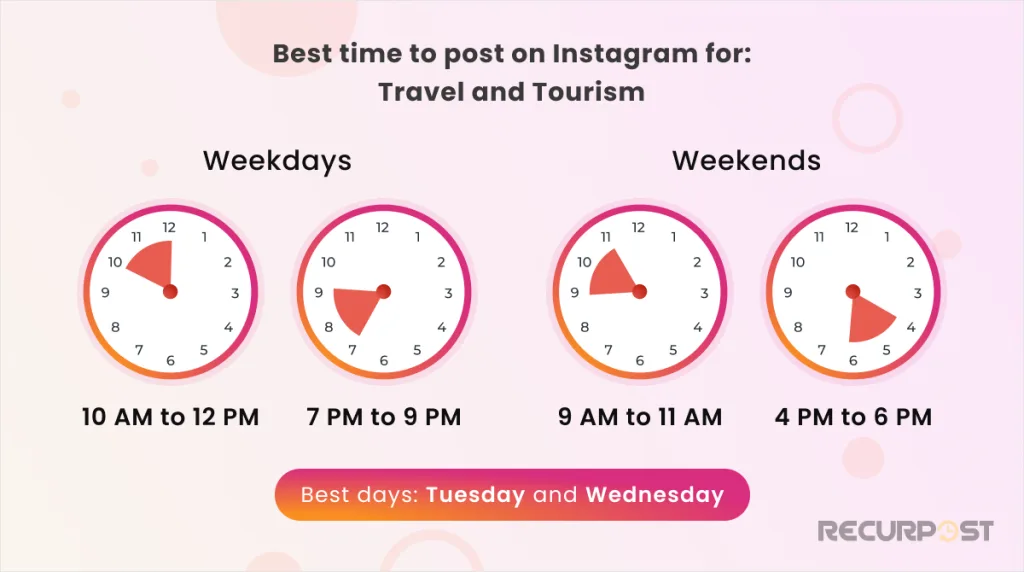
For travel and tourism, the ideal Instagram times are weekdays between 10 AM to 12 PM and 7 PM to 9 PM, capturing the imagination of audiences planning their next adventure.
Weekends from 9 AM to 11 AM and 4 PM to 6 PM also work well, aligning with leisurely browsing. Tuesdays and Wednesdays are the standout days for engagement in this sector.
Fashion and Apparel: Stylish Times for Stylish Posts
In the fashion and apparel industry, posting between 12 PM to 2 PM and 7 PM to 9 PM on weekdays aligns perfectly with fashion enthusiasts’ lunch breaks and evening relaxation times. On weekends, aim for 9 AM to 11 AM and 5 PM to 7 PM, especially on Saturdays, when engagement peaks as people seek style inspiration for the week ahead.
Best Time to Post on Instagram for Fitness and Wellness
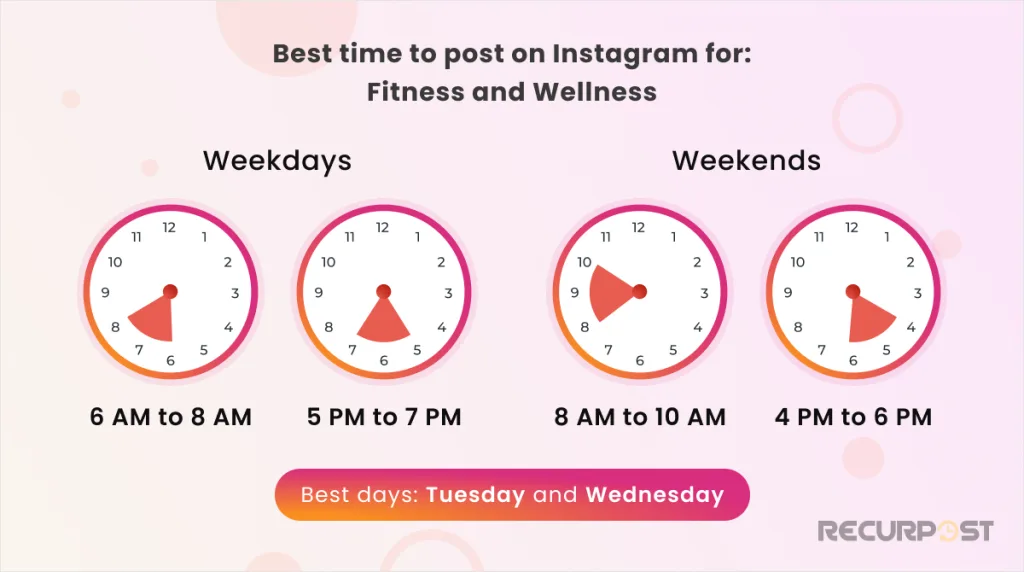
For fitness and wellness content, early mornings (6 AM to 8 AM) and evenings (5 PM to 7 PM) on weekdays are key, resonating with users’ workout routines and wellness activities. On weekends, the target audience is active from 8 AM to 10 AM and 4 PM to 6 PM. Tuesdays and Wednesdays are especially good for engaging with health-conscious followers.
Food and Beverage: Savory Lunchtimes and Cozy Evenings
The food and beverage industry sees the most interaction during lunch hours (12 PM to 2 PM) on weekdays and Sunday evenings. This timing is perfect for sharing mouth-watering content when people are thinking about their next meal. Weekends generally are great for engaging foodies planning their culinary adventures.
Digital Marketing/Social Media: Business Hours for Business Minds
For digital marketing and social media content, the best time to post on Instagram are within standard business hours on weekdays, particularly from 9 AM to 11 AM and 1 PM to 3 PM. This aligns with professionals and businesses being active online, mostly from Monday to Thursday.
Best Time to Post on Instagram for IT Brands
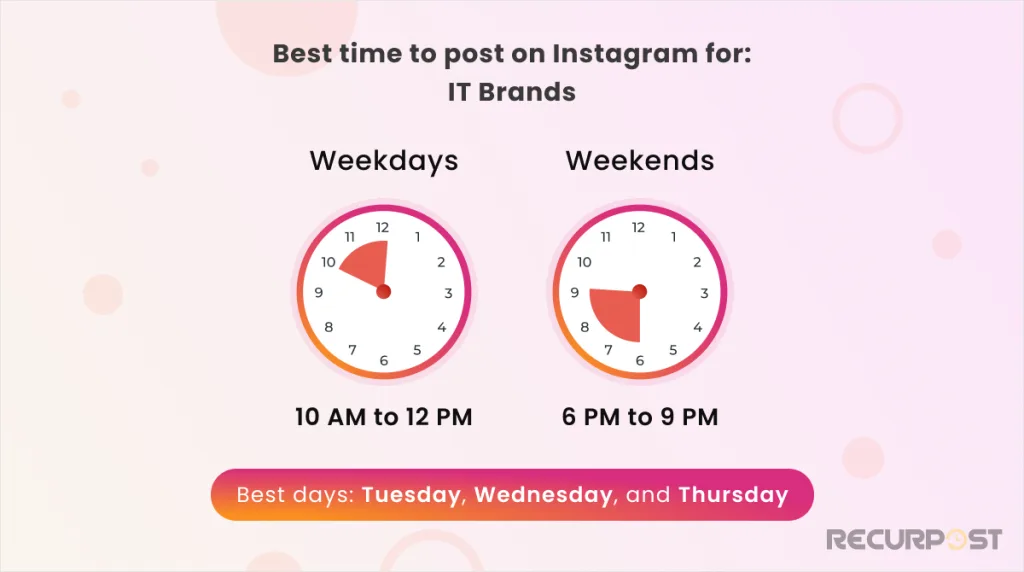
IT brands find the most engagement during late mornings (10 AM to 12 PM) on weekdays, a time when tech enthusiasts and professionals take breaks to check updates. Weekend afternoons also offer a significant window for engagement.
Peak days for this industry are Tuesdays, Wednesdays, and Thursdays, aligning with when tech audiences are most receptive to new information and innovations.
In terms of the best time to upload stories on Instagram, consider when your audience is most likely to be checking their phones for updates.
Typically, morning hours like 9 AM to 11 AM and evening hours from 7 PM to 9 PM on weekdays are ideal, with adjustments based on industry-specific trends as noted above.
For instance, if you’re in the travel industry, posting stories early in the morning or late in the evening can capture your audience’s attention as they plan their day or unwind.
Similarly, the best time to post reels on instagram should align with peak user activity times within your specific industry. For example, for fitness and wellness, early morning and evening are key times when followers might seek motivational content.
In the fashion sector, midday and late evening slots can be particularly effective to showcase new outfits or fashion tips when followers are likely to engage with leisurely content. Each industry’s highlighted times provide a useful guide to maximizing the impact of your reels by posting when your audience is most receptive.
The Three Pillars of Instagram Engagement
The three main pillars of engagement can help a user boost their Instagram profile with ease. These are not just pillars but are a secret weapon to your Instagram engagement.
Want to know which are those? Well then, move to the next section:
Interest: The Instagram algorithm is designed to prioritize content similar to what users have already liked or interacted with. That means if you’re consistently creating content your audience enjoys, the chances of them sticking around and engaging more go up. It’s kind of like your friend recommending movies based on your taste. If you want to dig deeper into how this works, check out our post on how the Instagram algorithm works.
Recency: Timing is everything, right? Instagram thinks so, too. The platform favors newer posts, putting them front and center. So, if you post when your audience is most active, you’re playing right into Instagram’s hands, giving your content a better shot at being seen. It’s like catching someone just as they’re looking for something to watch.
Relationship: Instagram is all about building community and not just about likes and views. If people regularly interact with your posts – think comments, shares, likes – Instagram takes this as a sign that they value your content. So, it bumps your posts higher on their feed. Hence, create content that sparks conversations and strengthens your bond with your followers.
Does Scheduling Instagram Posts Affect Engagement?
Scheduling Instagram posts is a great way to save time and stay organized, but does scheduling Instagram posts affect engagement?
The short answer is no.
There is no evidence to suggest that Instagram penalizes scheduled posts. In fact, scheduling posts can help you maintain a consistent posting schedule, which is important for engagement.
Here are some additional tips for scheduling Instagram posts effectively:
- Plan your content in advance: This will help you to stay consistent with your posting schedule and ensure that you have a variety of content to share.
- Use a scheduling tool: There are a number of different Instagram scheduling tools available, like RecurPost. These tools can help you to schedule your posts in advance and save you time.
- Promote your scheduled posts on other social media platforms: Share your scheduled Instagram posts on other social media platforms, such as Twitter and Facebook, to reach a wider audience.
- Use relevant hashtags: Hashtags are a great way to get your posts seen by more people. Use relevant hashtags in your scheduled posts to help people find your content.
How to Check Your best time to post on the Instagram App & Creator Studio
If you are just starting out, then you might want to follow the general best time to post on Instagram given by the experts, i.e., between 9 AM to 4 PM on weekdays, as during these hours people are habituated to using their phones more often.
However, if you are still not getting the results, then we recommend you use this tried and tested method, given by our experts. By using this method, you will gain a good insight into what works for your engagement and what doesn’t. The good news, it is a more personalized approach to finding YOUR best time to post on Instagram. Here is a short tutorial on this method:
Access Instagram Insights: First, make sure you have a Business or Creator account on Instagram, as this gives you access to Instagram Insights. Go to your profile, tap the menu (three lines), and then tap ‘Insights’.
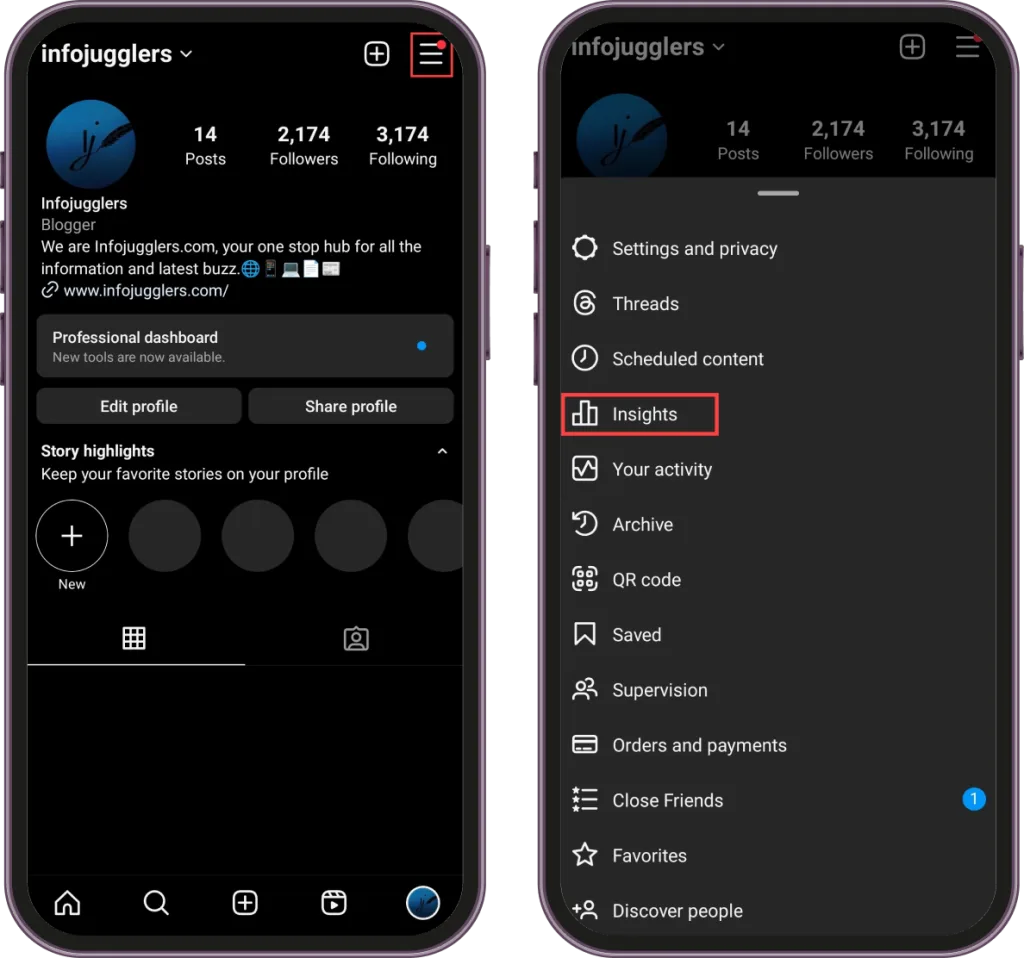
Analyze Your Audience’s Active Times: In Insights, under the “Overview tab,” look for the “Total followers” option. Scroll down and you’ll find data about when your followers are most active on the platform, broken down by days of the week and hours of the day.
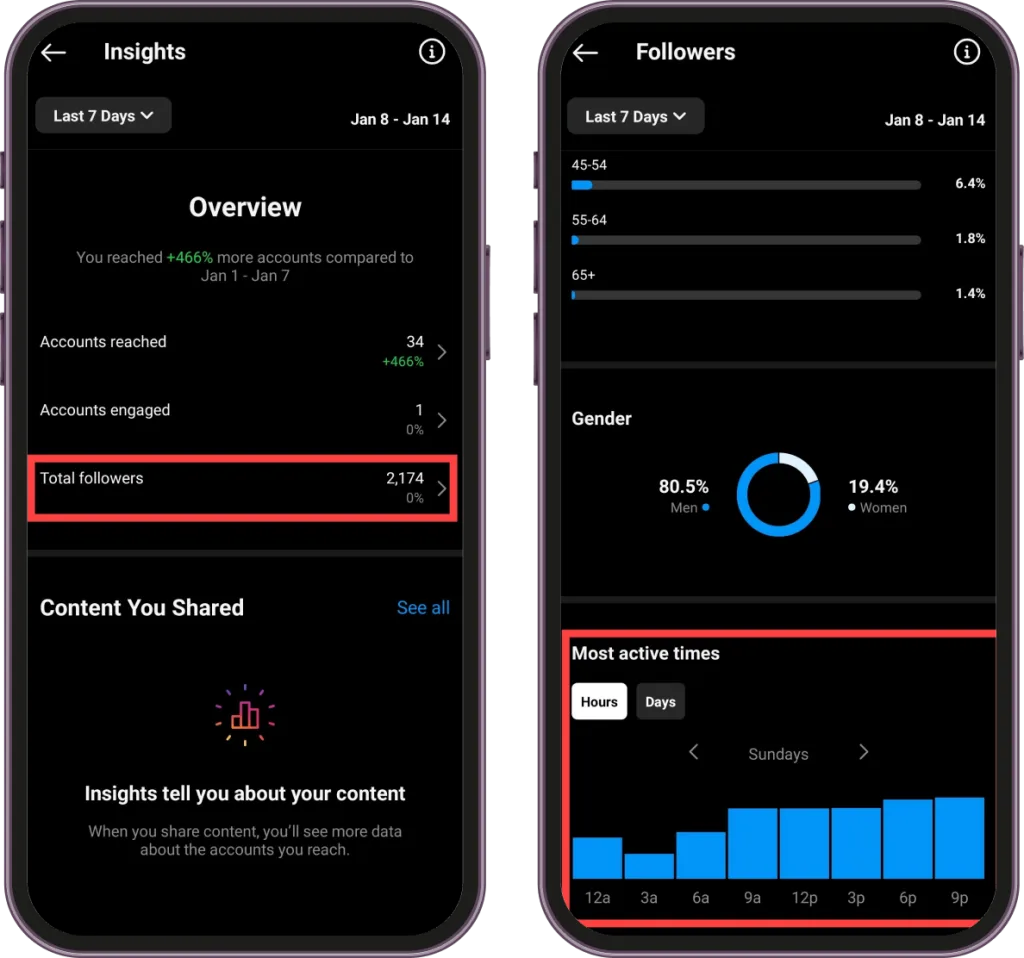
Record the Data in a Spreadsheet: Open a spreadsheet program like Microsoft Excel or Google Sheets. If you prefer Google Sheet, a template is attached below. If you prefer your own Excel sheet then, create a new sheet and label columns for days of the week and rows for hours of the day. Input the data from Instagram Insights into the spreadsheet, noting the peak activity times. Every time there is a good response, add one to the cell for that day and hour. Every time the post goes bust, subtract one for that day and hour.
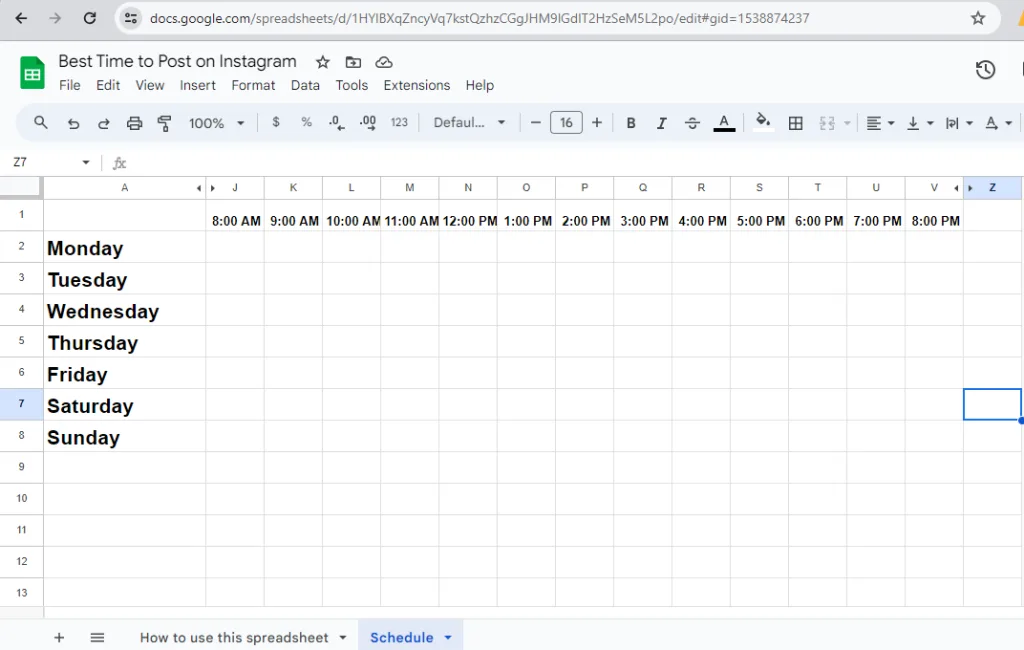
Identify Patterns: Over several weeks, regularly update your spreadsheet with the latest data from Instagram Insights. Look for patterns to emerge – the darker cell represents the best time, while the lighter ones represent the least or worst.
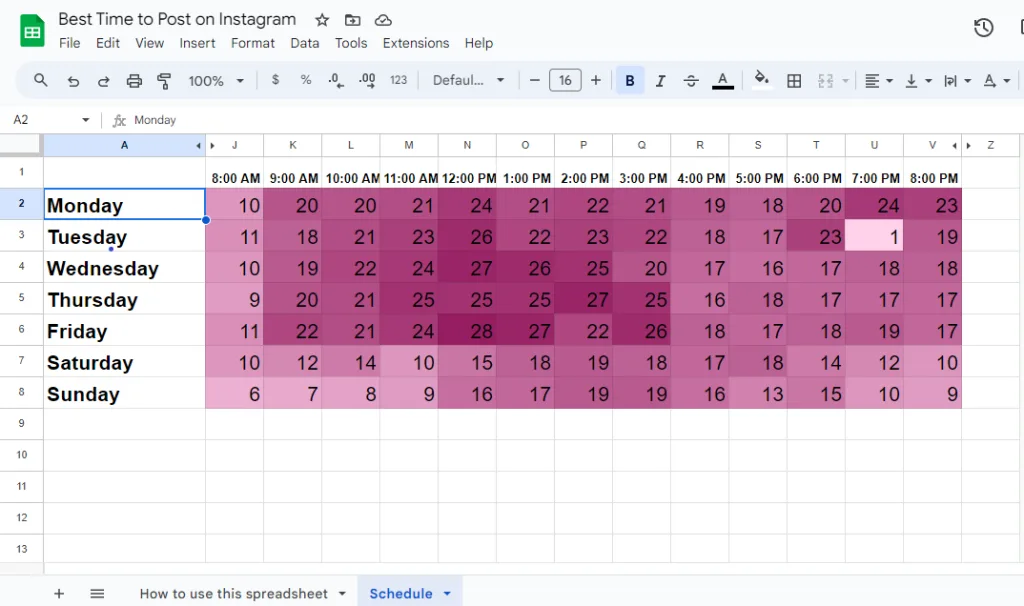
Test and Adjust: Based on your findings, schedule posts on Instagram during these identified peak times. Keep an eye on the engagement these posts receive. In your spreadsheet, track likes, comments, shares, and any other relevant metrics.
Iterate and Refine: Over time, you’ll gather enough data to accurately identify the best times to post for your specific audience. Adjust your posting schedule as needed based on ongoing insights and trends.
Stay Updated: Remember that audience behaviors can change, so it’s important to periodically revisit your analytics and update your spreadsheet to reflect any new patterns.
For your ease, we have linked the spreadsheet below. All you need to do is make a copy of it and then use it.
Third-Party Analytics Tools for Finding Your Best Posting Times
Although the built‑in Instagram Insights tool is helpful, leveraging advanced third‑party analytics tools can elevate your scheduling strategy by uncovering deeper trends in your audience’s activity. These platforms analyze historical data and identify optimized posting windows tailored to your account’s unique engagement patterns.
Popular Instagram Analytics Tools:
- Later examines past content performance to recommend personalized best times to post.
- Hootsuite Analytics provides robust reports that highlight when your followers are most active and when your content historically receives high engagement.
- Sprout Social uses an “optimal send time” feature to suggest the most effective posting hours.
- Iconosquare delivers detailed dashboards that reveal follower activity peaks and advise specific posting windows.
- Buffer offers scheduling insights based on when your previous posts got the best results. Using these tools alongside Instagram’s native analytics gives you a clearer engagement map and better chances of hitting the right time for maximum reach.
The worst time to post on Instagram
Like best times, there exist worst times that one should be aware of while posting on Instagram. Here are a few of them.
| Time Frame | Weekdays | Weekends | Notes |
|---|---|---|---|
| Late Night and Early Morning | After 9 PM and before 6 AM | After 10 PM and before 8 AM | Low engagement as most are sleeping or inactive |
| Standard Work Hours | 9 AM to 5 PM | N/A | Lower engagement due to work/school activities |
| Weekend Afternoons (Saturday) | Not Applicable | Afternoon (Time Varies) | Drop in engagement due to outdoor activities |
| Sunday Evenings | Not Applicable | Evening (Time Varies) | Mixed engagement as users prepare for the week |
| During Major Events | Varies (During event times) | Varies (During event times) | Engagement drops as attention shifts to events |
Late Night and Early Morning Hours: During both weekdays and weekends, very late at night (after 9 PM on weekdays and after 10 PM on weekends) and early in the morning (before 6 AM on weekdays and before 8 AM on weekends) are typically not optimal for engagement.
Most people are either sleeping or just starting their day and not actively checking their Instagram accounts. Given these trends, posting late at night on Instagram is generally not recommended as engagement tends to be lower, with most users less likely to be active and scrolling through their feeds during these hours.
Standard Work Hours on Weekdays: On weekdays, the hours from 9 AM to 5 PM often show lower engagement because many people are occupied with work or school activities.
Weekend Afternoons: Specifically, on Saturdays, afternoons can experience a drop in engagement as this is a common time for outdoor activities, errands, or social events.
Sunday Evenings: Engagement can be hit or miss on Sunday evenings. While some users might be active, others may be preparing for the week ahead and be less engaged on social media. Sundays are thus the worst days to post on Instagram.
Check out our comprehensive guide on the best and worst times to post on social media for maximum engagement!
During Major Events: Anytime there is a major event, like a popular sports game or a significant cultural event, Instagram reels activity can decrease as attention is diverted elsewhere. My mentor always said It is the worst time to post Reels on Instagram if people are busy watching a bigger screen.
Additional tips to garner engagement apart from the best times
Identifying the best posting times is just one element of a successful Instagram strategy. To drive more engagement, you need a broader approach. Start by being both authentic and consistent. Share genuine content that reflects your brand’s personality, and keep a regular posting rhythm to remain visible and trustworthy to your audience.
Make full use of Instagram Analytics. It helps uncover the type of content your followers prefer and when they’re most active. This insight is vital in optimizing future posts and increasing your chances of connecting with your audience.
Hashtag strategy also matters. Use popular, trending, and relevant hashtags that align with your content. These tags expand your reach and bring in users actively searching for related topics.
Enhance your content with trending music. Adding the right audio can boost engagement by making your reels and stories more entertaining and relatable to current trends.
Embrace Instagram’s evolving features. Tools like Reels, IGTV, and interactive story stickers offer new ways to engage followers. Being an early adopter of these can give you an edge.
Experiment with various post formats. Don’t stick to a single style; rotate between reels, images, videos, and carousels to keep your feed dynamic and appealing.
If you’re looking to boost your engagement further, consider leveraging influencer collaborations. Check out our guide on effective Instagram influencer marketing techniques to learn how influencers can help amplify your content and reach a broader audience.
Our Other Studies:
- Best times to post on Facebook
- Best time to post on TikTok
- Best time to upload to YouTube
- Best time to post on Twitter
- Best time to post on Pinterest
- Best time to post on Reddit
Conclusion
Understanding the best time to post on Instagram is critical for building meaningful engagement. Posting when your followers are most active significantly increases the chances of your content being noticed, liked, and shared.
This strategy goes beyond timing; it’s about forming deeper connections. By carefully monitoring audience behavior and trends, you can shape a content plan that delivers maximum value and visibility.
Utilize Instagram’s built-in analytics to evaluate when your audience is online and test different slots to discover the best time to post on Instagram for your brand. The platform’s landscape constantly shifts, so staying adaptable is key. With consistent, strategic timing, you can grow your reach and establish a loyal community around your content.
Frequently Asked Questions
1. When should I post on Instagram?
Well, there’s no perfect answer for the query, but generally, posting on mid-week days like Tuesday to Thursday, especially during lunch hours (11 AM to 1 PM) and evenings (7 PM to 9 PM), works great. Just keep in mind, your audience’s routines and their time zones can make a difference here.
2. Is Monday the best time to post on Instagram?
Yes, Monday can be a good day to post on Instagram, particularly if your audience is looking to kickstart their week with fresh content. It’s often a time when users are getting back into their routine and may be more likely to check social media to catch up after the weekend. For specific industries like digital marketing or social media, Monday is especially effective, as it’s a prime time to engage professionals who are setting their agendas and looking for updates at the start of the work week.
3. What’s the best day of the week to post on Instagram?
The best day of the week to post on Instagram can vary depending on your audience and their habits, but generally, midweek days like Tuesday, Wednesday, and Thursday tend to see high engagement. Many studies and data analyses suggest that these days are effective because users are well into their weekly routines but not yet winding down for the weekend, making them more likely to engage with content. Specifically, posting on Wednesday has often been cited as optimal for achieving maximum visibility and engagement.
4. What is the best time to post on Instagram on Sunday?
On Sundays, the best time to post on Instagram is typically during midday from 11 AM to 1 PM and in the early evening from 6 PM to 9 PM. These times align with how people generally use their Sundays: relaxing, scrolling through their feeds during a leisurely lunch, or preparing for the week ahead in the evening. Posting during these windows can help you capture your audience’s attention when they’re more likely to be relaxed and engaging with content.
5. Does it matter what time you post on Instagram?
Yes, the time you post on Instagram can significantly impact the engagement your content receives. Instagram’s algorithm tends to prioritize showing newer posts in users’ feeds, so posting when your audience is most active is crucial for maximizing visibility and interaction.
6. Is Saturday the best time to post on Instagram?
Saturday can be a good time to post on Instagram, but it often depends on your audience and the nature of your content. Saturdays generally see different user behavior compared to weekdays, with people typically engaging more in leisure activities and potentially checking social media at different times.
7. What is the best time to post on Instagram for beauty brands to maximize engagement?
The best time to post on Instagram for beauty brands includes weekday mornings (7 AM – 10 AM), lunch breaks (12 PM – 2 PM), and evenings (6 PM – 9 PM), which are peak engagement periods when users actively check their feeds. Each day has specific optimal windows:
Monday: 6 AM – 7 AM, 10 AM – 2 PM, 7 PM – 9 PM
Tuesday: 7 AM – 10 AM, 12 PM – 1 PM, 6 PM – 8 PM
Wednesday: 6 AM – 7 AM, 11 AM – 1 PM, 3 PM – 5 PM
Thursday: 6 AM – 7 AM, 9 AM – 12 PM, 6 PM – 7 PM
Friday: 6 AM – 7 AM, 11 AM – 3 PM, 2 PM – 4 PM
Saturday: 7 AM – 9 AM, 11 AM – 1 PM
Sunday: 11 AM – 2 PM, 7 PM – 9 PM

Dr. Dinesh Agarwal, founder of RecurPost, holds a PhD in Cloud Computing and transitioned from academia to social media innovation in 2013. He built RecurPost into an enterprise-grade automation platform now used by over 100,000 businesses worldwide. Beyond leading RecurPost, Dr. Agarwal shares insights on social media marketing through talks, podcasts, and articles, with a focus on content optimization and algorithm-driven distribution.

